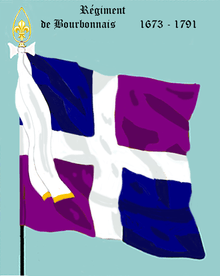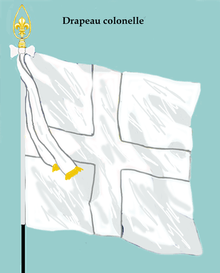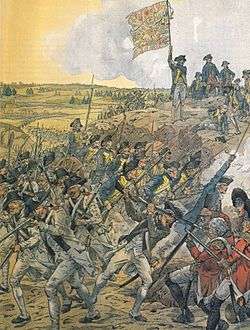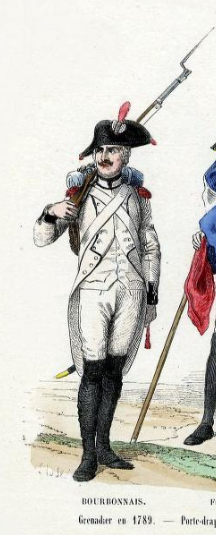Régiment de Bourbonnais
The Bourbonnais Regiment (Le Régiment de Bourbonnaise, Regiment of Bourbonnais), was a royal regiment of the French Ancien Régime formed in 1597. After being re-formed and disbanded multiple times, it eventually gained the name of Régiment de Bourbonnais, and shortly after joined the regular army. The unit would go on to serve in all the major wars of the period before being disbanded and reformed after the French Revolution. The successor of the regiment continued to exist until 1940 when it was disbanded following the Battle of France.
| Régiment de Nerestang Régiment de Bourbonnais | |
|---|---|
 Regimental colours (Drapeau d'Ordonnance) from 1673 to 1791 | |
| Active | 1597–1601 1602–1604 1610–1791 |
| Country | |
| Allegiance | King of France French Nation |
| Branch | |
| Type | Line Infantry Regiment |
| Size | Largest at 4 Battalions, disbanded with 2 |
| Recruiting Area | Bourbonnais |
| Colors | Royal Blue and White |
| Insignia | |
| Colonel's Colours |  |
American Revolutionary War

Preparation
When the Declaration of Independence was announced, the regiment was still on garrison duty, and shortly after left Corsica for Bourbonnais to fill its ranks. In 1779, after the Battles of Saratoga, the French declared war on the British, and the regiment moved to Brittany, then to Rennes, and finally Brest in 7 April 1780. When the regiment arrived in Brest, it was assigned to what became known as Expédition Particulière, lead by Général Jean-Baptiste de Vimeur, Comte de Rochambeau. In March 1781, the regiment was employed as marines on the Ardent and Jason during the Naval Action of the Chesapeake Bay. On 8 April 1780 the convoy embarked for the United States, and on 11 July 1780 arrived in Newport, Rhode Island.[1][2][3]
Deployment & the Chesepeake

Upon arrival the regiment took up quarters in the town and remained there through the winter, it was only in June 1781 that the army was concentrated and united with the American Army. Later, the armies made their way to the town of Yorktown as Nathanael Greene's Southern Campaign came to an end. On 21 July, around 2500 men of the army, consisting of troops from the Bourbonnais, Royal-Deux-Ponts, and a flying column battalion of the Soissonnais fought a reconnaissance battle in Kingsbridge, New York, which forced the British troops back into the city. On the 15th August after excessive marching through extreme heat arrived in Philadelphia, and were immediately greeted with kisses, applause, and flowers and the American civilians new who they were immediately, and what they were planning to do. As the regiment arrived towards the city centre, flags of the two countries were flown[Notes 1] and marched pass congress.[1]
Yorktown
On 28 September, the regiment was one of the first to make the assault into Yorktown on the far left flank. The regiment opened the trenches on the night of October 6-7 1781, and on the 15th of the same month it vigorously repulsed a sortie. The regiment immediately occupied all the posts of its attack and inscribed upon its colours, a new victory "Yorktown, 1781". On the 14th the regiment took up quarters in Williamsburg, and in 1782 marched north to the Hudson, thence to Rhode Island, and Boston to where it embarked on the fleet of Louis-Philippe de Rigaud, Marquis de Vaudreuil, bound for the West Indies. Upon arrival back into France, the regiment was sent to Metz. During this period, the regiment was organised into the following structure (from Right to left of the line): Compagnie des Grenadiers, Compagnie de Desondes, Compagnie du Plessis, Compagnie de Montfort, Compagnie de Losse, de Bayae, Compagnie de Cazals, Compagnie de la Brue, Compagnie du Chevalier, Compangnie de Chalvet, and the Compagnie de Chasseurs—Compagnie de Lassuderie.[1][2]
In 1787 the fear of another war with Great Britain caused the regiment to move to Lisieux, but was sent back to Metz in December. In April 1791, the regiment was ordered to Strasbourg, lost their provincial title to become 13éme Régiment d'Infanterie de Ligne (Bourbonnais), and shortly after assigned to the Army of the Rhine. Even though the Régiment de Bourbonnais lineage ended that year, its traditions were continued by the 13th which was dissolved by 1796. In 1803 Napoleon brought back the old regimental system and the 13th was re-instated with the lineage continuing from their predecessors.[1][4]
Uniforms
Uniforms which the regiment was equipped with included:
- Uniforms during Ancien Régime
 Uniform between 1720 and 1734
Uniform between 1720 and 1734 Uniform between 1734 and 1757
Uniform between 1734 and 1757 Uniform between 1762 and 1774
Uniform between 1762 and 1774 Uniform in 1776 (experimental)
Uniform in 1776 (experimental) Uniform between 1776 and 1779
Uniform between 1776 and 1779 Last Royalist Uniform: Between 1779 and 1791
Last Royalist Uniform: Between 1779 and 1791
As part of the 1779 uniform regulations, the regiment was granted a crimson collar, cuffs and lapels and yellow buttons.
Regimental Colours
The Régiment de Bourbonnais maintained the same two colours or drapeaus throughout their existence, these included the Regimental Colours Drapeau d'Ordonnance and Colonel's Colours Drapeau Colonel.[2]
 Regimental Colours between 1673—1791, consists of two azure and two violet squares with a white cross.
Regimental Colours between 1673—1791, consists of two azure and two violet squares with a white cross. Colonel's colours, 4 white squares with a white cross.
Colonel's colours, 4 white squares with a white cross.
Commanding Officers
Commanding officers of the regiment included:[1]
- 1597—1611 Philibert, Marquis de Nérestang
- 1611—1614 Jacques d'Aumont, Baron de Chappes
- 1614—1631 César d'Aumont, Baron de Chappes
- 1631—1639 Jean-Claude, Marquis de Nérestang
- 1639—1645 Charles, Marquis de Nérestang
- 1645—1657 Anne-Alexandre de l'Hôpital, Comte de Sainte-Mesme
- 1657—1665 Jacques de Vipart, Marquis de Silly
- 1665—1673 Michel, Marquis de Castlenau
- 1673—1687 Pomponne, Marquis de Reffuges
- 1687—1700 Louis-Pierre-Armand d'Aloigny, Marquis de Rochefort
- 1700—1709 Louis de Brichanteau, Marquis de Nangis
- 1709—1727 Louis-Antoince de Gramont, Comte de Lesparre
- 1727—1740 Joseph-Marie, Duc de Boufflers
- 1740—1746 Antoine-Antonin de Gramont, Duc de Lesparre
- 1746—1747 Louis de Biran, Comte de Gohas
- 1747—1761 Vincent-Sylvestre de Thimbrune, Comte de Valence
- 1761—1770 Joseph Roger de Verdusan, Marquis de Miran
- 1775—1783 Anne Alexandre Marie Sulpice Joseph de Montmorency, Marquis de Laval[2]
- 1783—1791 Charles-Louis-Victor, Prince de Broglie
Notes
- At this time, the 'Flag of France' was the colours of the House of Bourbon, a pure white flag. It wasn't until 1783 when the coat of arms were added along with gold Fleur-de-lises. This is also evident by the fact the Colonel's Colours (usually the national flag) for the regiment was pure white with slight grey used for marking a cross. (See bottom of infobox).
Footnotes
- Susane, Volume III, pp. 290—331.
- Keim, pp. 565—8.
- Smith, American War of Independence, p. 174–81.
- Smith, Napoleonic Wars, pp. 42–6.
References
- Louis Susane, History of the Ancient French Infantry, Volume III, 1851 Naval and Polytechnical Military Library of Paris, Paris, France.
- Chez Michel, Ordonnance du Roi, sur L'Organisation de L'Armée, 1815 Paris, France. [in French]
- Deborah Randolph Keim, Rochambeau A Commemoration by the Congress of the United States of America of the Services of the French Auxiliary Forces in the War of Independence, Congress/Pennsylvania Historical Society, Washington 1907.
- Digby Smith, Kevin E. Kiley, and Jeremy Black, An Illustrated Encyclopedia of Uniforms of the American War of Independent, 2017 Lorenz Books, London, United Kingdom. ISBN 978-0-7548-1761-1.
- Digby Smith & Jeremy Black, An Illustrated Encyclopedia of Uniforms of the Napoleonic Wars, 2015 Lorenz Books, London, United Kingdom. ISBN 978-0-7548-1571-6.